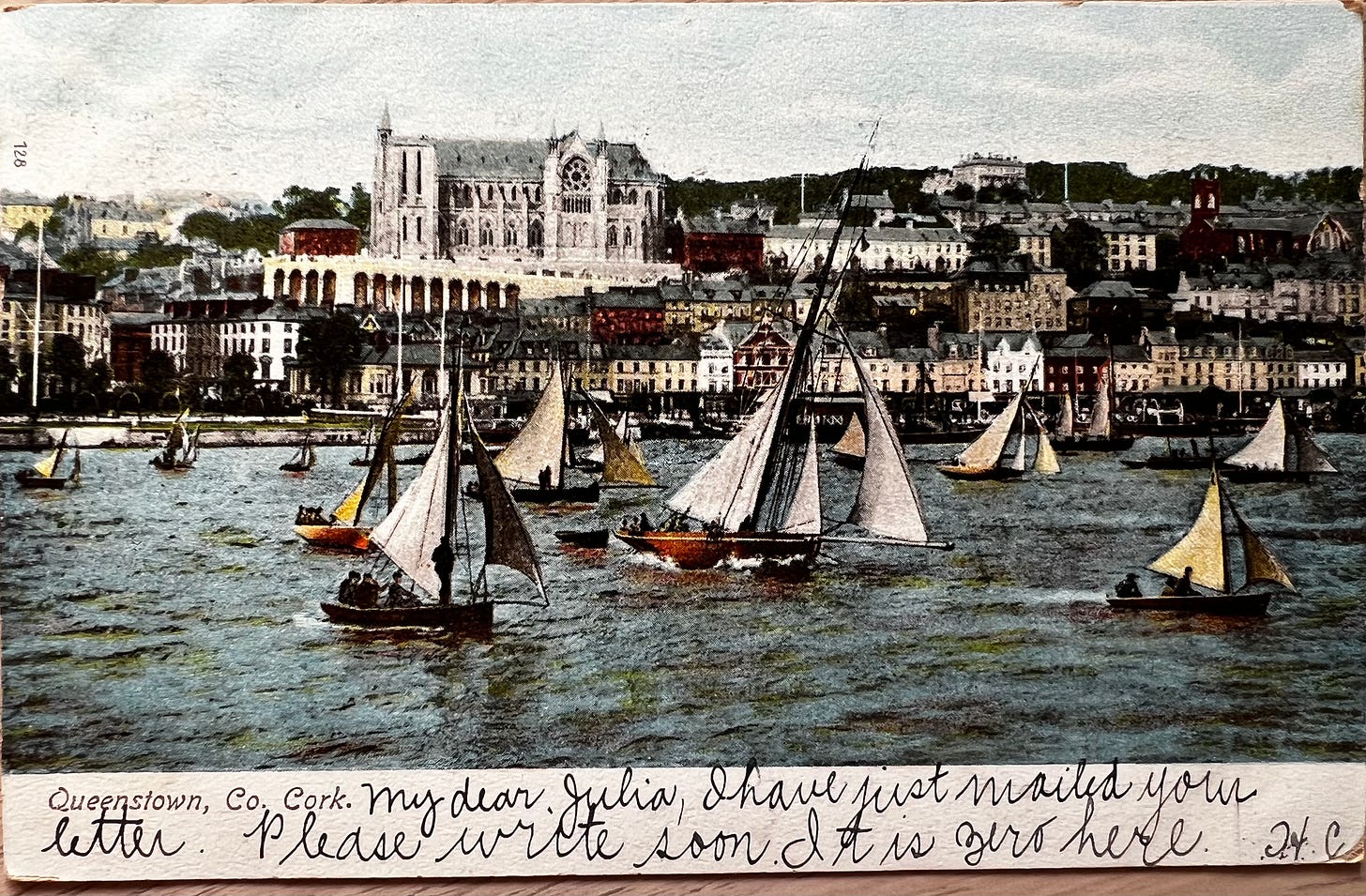In 1907, when this postcard was mailed, Queenstown, County Cork, Ireland, on the south coast, was an important port, as the picture on the card demonstrates. As part of the broader Irish nationalist movement, culminating in the Irish War of Independence (1919-1921) and the creation of the Irish Free State, now the Republic of Ireland (1922), there was a push to remove British imperial influences from various aspects of Irish life, including place names, and Queenstown was renamed Cobh. The renaming of Queenstown to Cobh was one of many symbolic acts undertaken during this time to assert Irish identity and distance the country from its British colonial past.
The name "Cobh" is derived from the Irish word "An Cóbh," which means "the cove." The change of the town's name was officially recognized in 1920, and since then, it has been known as Cobh. Despite the name change, the town's historical significance as a major port and its connections to maritime history remain, making it a popular tourist destination in Ireland. (Maybe you’ve seen Cobh in the film Angela’s Ashes?)
Here are some interesting facts about Queenstown:
1. Major Transatlantic Port: Queenstown was a key port for transatlantic travel, serving as the last port of call for many ships departing from Europe bound for the United States. It was a popular departure point for Irish emigrants seeking a new life in America.
2. RMS Titanic: In 1912, Queenstown was the final port of call for the ill-fated RMS Titanic before it embarked on its tragic maiden voyage. Some passengers boarded the ship here, and the White Star Line tender, SS Nomadic, ferried them from Queenstown to the Titanic. There’s a museum in Cobh to the Titanic that’s worth a visit.
RMS Lusitania: On May 7, 1915, during World War I, the British ocean liner RMS Lusitania was torpedoed and sunk by a German U-boat off the coast of Ireland, not far from Queenstown. The Lusitania was a large passenger ship and was one of the fastest and most luxurious vessels of its time. The sinking of the ship had a profound impact on public opinion, particularly in the United States, as it played a role in eventually drawing the US into the war. Queenstown, being the last port of call before the Lusitania headed across the Atlantic, played a crucial role in the tragedy. The ship had departed from New York City, and when it reached Queenstown, it made a brief stop to pick up and drop off passengers and cargo. Some of the passengers who boarded the Lusitania in Queenstown were Americans, which further intensified the outrage in the United States following the sinking. In total, 1,198 people lost their lives in the sinking, including 128 Americans. The sinking of the Lusitania, along with other factors, contributed to the increasing tensions between the United States and Germany, eventually leading the US to declare war on Germany in 1917. Today, there are several memorials in Cobh to remember the victims of the Lusitania sinking, and the event remains an important part of the town's history and connection to maritime heritage.
4. Naval Base: The town also served as a British naval base, with a significant naval presence in the area. It was strategically important, given its location on the southern coast of Ireland.
5. Architectural Heritage: Queenstown featured a mix of architectural styles, including Georgian and Victorian buildings. The town's architecture was influenced by its maritime history and was a testament to its significance as a port town.
6. Population and Trade: The population of Queenstown in 1907 was relatively modest, with around 12,000 inhabitants. The local economy was centered around maritime trade, shipbuilding, and associated services.
7. Social Life: Like many Irish towns, Queenstown had a vibrant social life with pubs, shops, and community gatherings. The local culture was influenced by Irish traditions and the town's maritime connections.
The postcard message, which is written on the same side as illustration says, "My dear Julia, I have just mailed your letter. Please write soon. It is zero (?) here. H.C."
The postcard was mailed from New York, NY on January 24, 1907, to a "Miss Julia Parker, Hyde Park, Dutchess County, New York.
We can't know if "H.C.," the author, had been to Queenstown or if he or she had simply purchased this card in New York since it was published by the American News Company, NY.
As to "Miss Julia Park"—there is no Julia Parker in the 1910 census for Hyde Park. There is one listed in 1900, though she is five years old at the time. Is this our Miss Julia? Perhaps. She would have been twelve in 1907. If this is our Miss Julia, in 1900 she was living with her parents and two other siblings. Julia was the middle child. Cecil, her father, died in 1906, which may explain why Julia was no longer living in Hyde Park in 1910. But Julia Parker is a common name and there are several in the census records.
I do find it fascinating that in 1907, the only address needed for Julia to receive this postcard was simply the town's name of Hyde Park. There were approximately 2,400 people living in Hyde Park, NY in 1905, when a population census was undertaken. The rural community relied on farming and was known for its lush, green landscapes and views of the Hudson River. Many wealthy and prominent people had estates in Hyde Park, including Franklin D. Roosevelt (president from 1932-1944) and the Vanderbilt Mansion, which began construction in 1896. Both of these homes are open for tours today.






